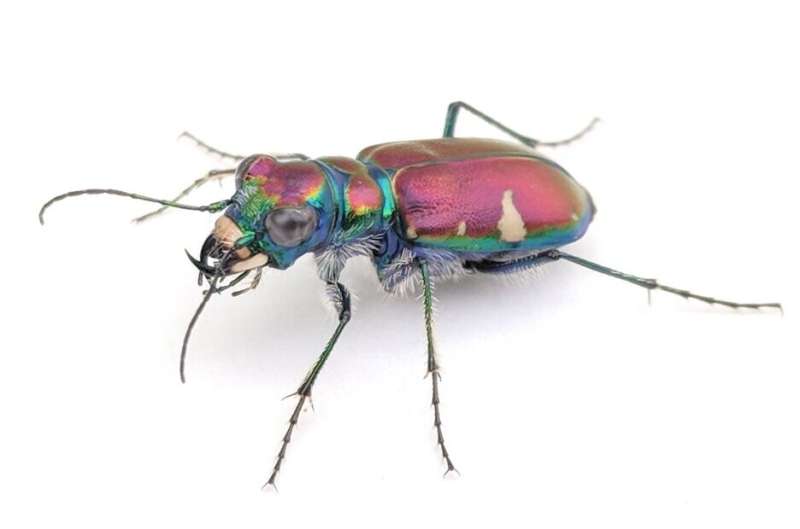Tiger beetles use ultrasonic mimicry to defend against bats

May 14, 2024
The content of this article has been validated based on the editorial process and policies of Science X. The credibility of this document is confirmed by the following attributes:
- Fact checked
- Reviewed by peers
- Trusted source
- Proofread
The content has been verified by Florida Museum of Natural History
Bats, being the principal predator of insects that fly at night, have influenced the evolution of various species of their prey. This has led to the development of an early warning system, in the form of ears tuned to high-frequency bat echolocation, in insects like moths, beetles, crickets, and grasshoppers. However, tiger beetles have taken this one step further.
When a tiger beetle hears a bat, it reciprocates with its own ultrasonic signal – a behavior whose purpose was unknown for three decades. Harlan Gough, the lead author on a study recently published in the journal Biology Letters, provided some clarity. He reasoned that, despite the risk of aiding bats in locating them, tiger beetles must gain massive benefits from emitting the sound.
According to research, tiger beetles are the only beetles known to produce such ultrasonic responses to bat predation. Conversely, an estimated 20% of moth species are known to possess this ability. This information aids in understanding the behavior in different insects. 'This was a really fun study, we got to investigate the story layer by layer,' Gough commented.
Researchers first confirmed that tiger beetles produce ultrasound in response to bat predation. As bats navigate the night sky, they emit ultrasonic pulses intermittently, creating mental snapshots of their immediate surroundings. To test this, researchers played recorded bat echolocation sequences to tiger beetles to observe their reaction. When the beetles fly, their hard shell opens, revealing two hind wings that facilitate flight, with their protective elytra held up out of the way.
Researchers conducted their study over two summers in southern Arizona, examining twenty tiger beetle species. Of these species, seven responded to the bat attack sequences by swinging their elytra slightly backward. This created a clapping-like sound, which humans perceive as a faint buzz. However, bats, with their heightened auditory sensitivity, hear it loud and clear.
'Being able to respond to bat echolocation is rarer than merely hearing echolocation,' Gough explained. The experiment ruled out the possibility that tiger beetles jam bat sonar by producing successive clicks. Tiger beetles' ability to produce ultrasound is too rudimentary for this sophistication.
Instead, the researchers proposed that tiger beetles, which can emit defensive chemicals like benzaldehyde and hydrogen cyanide, used the ultrasound as a warning signal to bats – similar to many moth species.
'These compounds effectively deter some insectivorous predators,' Gough observed. 'When you hold some tiger beetles in your hand, you can actually smell some of these compounds.'
To test this theory, the scientists fed 94 tiger beetles to big brown bats which are known to prefer beetles as their diet. Surprisingly, 90 were completely consumed, two were partially eaten and only two were rejected – suggesting that the defensive chemicals of the beetles were ineffective against the bats.
This was the pioneering attempt at experimentally verifying whether tiger beetles were harmful to bats, according to Akito Kawahara, director of the museum's McGuire Center for Lepidoptera and Biodiversity.
'It's not always the case that identifying a chemical would guarantee its effectiveness against a specific predator,' Kawahara noted, adding 'you can't be certain until you experiment with the predator.'
It turned out tiger beetles don't use ultrasound to warn bats of their noxiousness. But there was one last possibility. Some moths produce anti-bat ultrasound even though they are palatable. Scientists believe these moths are trying to trick bats by acoustically mimicking the ultrasonic signals of genuinely noxious moth species.
Could tiger beetles be doing something similar? The researchers compared recordings of tiger beetle ultrasound, collected earlier in the study, with recordings of tiger moths already in their database. Upon analyzing the ultrasonic signals, they found a clear overlap and the answer to their question.
Tiger beetles, which do not have chemical defenses against bats, produce ultrasound to mimic tiger moths, which are noxious to bats.
But this behavior is limited to tiger beetles that fly at night. Some of the 2,000 species of tiger beetles are active exclusively during the day, using their vision to chase and hunt smaller insects, and don't have the selective pressure of bat predation. The 12 diurnal tiger beetle species that the researchers included in the study are evidence of this.
'If you get one of those tiger beetles that goes to sleep at night and play bat echolocation to it, it makes no response at all,' Gough said. 'And they seem to be able to pretty quickly lose the ability to be afraid of bat echolocation.'
Researchers suspect there may be even more undiscovered examples of ultrasonic mimicry, given how understudied the acoustics of the night sky are.
'I think it's happening all over the world,' Kawahara said. 'With my colleague, Jesse Barber, we have been studying this together for many years. We think it's not just tiger beetles and moths. It appears to be happening with all kinds of different nocturnal insects, and we just don't know simply because we haven't been testing in this manner.'
These delicate ecological interactions are also at risk of being disrupted soon. Acoustic mimicry needs a quiet environment to work, but human impacts like noise and light pollution are already altering what the night sky looks and sounds like.
'If we want to understand these processes, we need to do it now,' Kawahara said. 'There are amazing processes taking place in our backyards that we can't see. But by making our world louder, brighter and changing the temperature, these balances can break.'
Juliette Rubin, former graduate student at the University of Florida and Jesse Barber of Boise State University were also authors on the study.
Journal information: Biology Letters
Provided by Florida Museum of Natural History




